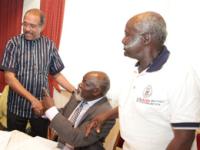Cultural structures and systems can facilitate or inhibit the success of HIV programs such as voluntary male circumcision, PMTCT and social protection. Thus science and culture must work in tandem to enable adoption of innovations. To promote voluntary male circumcision, the government programme has recognized the importance of working with social structures to catalyze behavioral transformation among non-circumcising communities.
As agents of change, these leaders are paving the way on how communities can address challenges in the AIDS response while still retaining the positive cultural values and practices that hold communities together.
Michel Sidibé, UNAIDS Executive Director
Michel Sidibé, UNAIDS Executive Director, had an opportunity to visit the Luo Council of Elders in the western part of Kenya to discuss their role in social transformation. As guardians of traditions in the region, the Elders guide communities in many aspects of health and sexual practices.
Among their many achievements, the Elders have been instrumental in reinstatement of widows who had been disinherited following the death of their husbands from AIDS related illness. By speaking out against ingrained stigma, the Elders have facilitated community acceptance for more than 198 widows who would have been considered outcasts.
“I am very impressed with the work that the Luo Council of Elders has done to lead their communities. As agents of change, these leaders are paving the way on how communities can address challenges in the AIDS response while still retaining the positive cultural values and practices that hold communities together”, said Michel Sidibe.
Another example on how the Elders are forwarding the response to HIV is in the process of rolling out male circumcision. Male circumcision is now recognized as an important HIV prevention strategy, and the government began offering the service in December 2007. HIV prevalence among uncircumcised men in 2007 was found to be three times higher (13.2%) than among men who were circumcised (3.9%).
Male circumcision is not traditionally practiced in some parts of western Kenya, but with recent efforts there has been an upsurge of demand. Over 20,000 men have undergone voluntary medical male circumcision over the past few months. The Elders have been instrumental in promoting and generating this demand.




